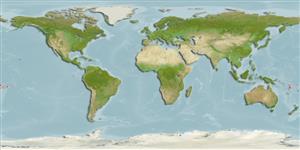Environment: milieu / climate zone / rango de profundidad / distribution range
Ecología
marino asociado a arrecife; no migratorio; rango de profundidad 3 - 60 m (Ref. 37816). Tropical; 11°S - 16°S
Western Pacific: northern Great Barrier Reef to Samoa; including Indonesia.
Tamaño / Peso / Age
Madurez: Lm ? range ? - ? cm
Max length : 10.0 cm TL macho / no sexado; (Ref. 9710)
Espinas dorsales (total) : 14; Radios blandos dorsales (total) : 16 - 17; Espinas anales: 3; Radios blandos anales: 17 - 18.
Body shape (shape guide): short and / or deep; Cross section: compressed.
Found among coral and sponge of seaward reef slopes (Ref. 37816). Cryptic, seldom seen by divers. Feeds on flake food and brine shrimp (Ref. 37816). Rarely exported through the aquarium trade (Ref. 48391).
Life cycle and mating behavior
Madurez | Reproducción | Puesta | Huevos | Fecundidad | Larva
Randall, J.E., G.R. Allen and R.C. Steene, 1990. Fishes of the Great Barrier Reef and Coral Sea. University of Hawaii Press, Honolulu, Hawaii. 506 p. (Ref. 2334)
IUCN Red List Status (Ref. 130435: Version 2025-1)
Threat to humans
Harmless
Human uses
Pesquerías: comercial; Acuario: Comercial
Herramientas
Special reports
Download XML
Fuentes de Internet
Estimates based on models
Preferred temperature (Referencia
123201): 28.1 - 29, mean 28.4 °C (based on 50 cells).
Phylogenetic diversity index (Referencia
82804): PD
50 = 0.5000 [Uniqueness, from 0.5 = low to 2.0 = high].
Bayesian length-weight: a=0.03090 (0.01378 - 0.06932), b=2.88 (2.69 - 3.07), in cm total length, based on LWR estimates for this (Sub)family-body shape (Ref.
93245).
Nivel trófico (Referencia
69278): 2.8 ±0.3 se; based on size and trophs of closest relatives
Resiliencia (Referencia
120179): Alto, población duplicada en un tiempo mínimo inferior a 15 meses (Preliminary K or Fecundity.).
Fishing Vulnerability (Ref.
59153): Low vulnerability (10 of 100).
🛈
